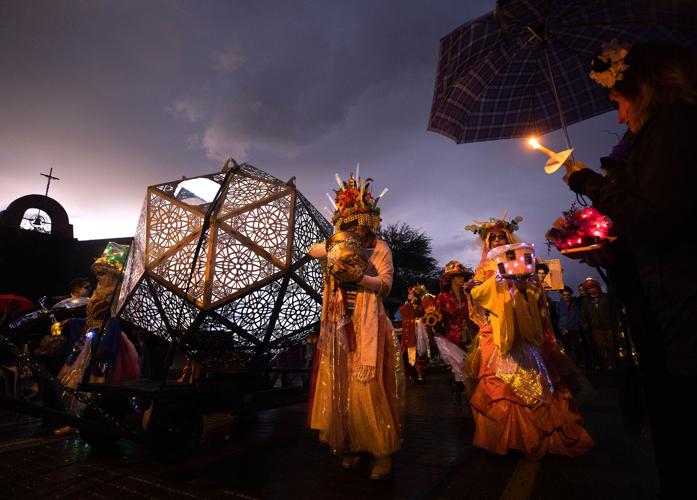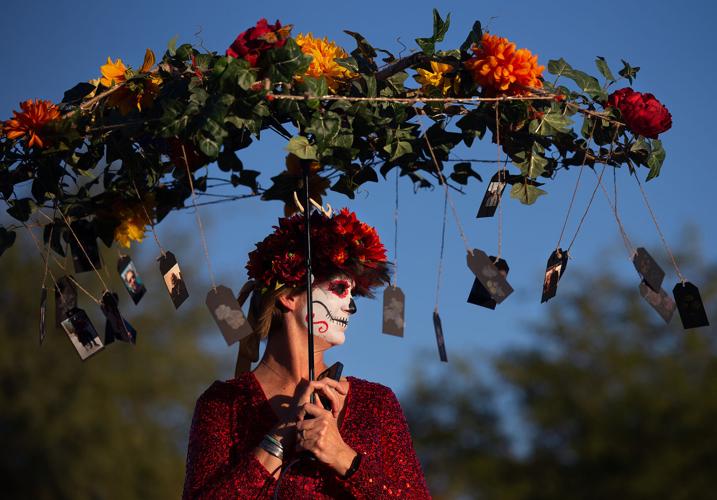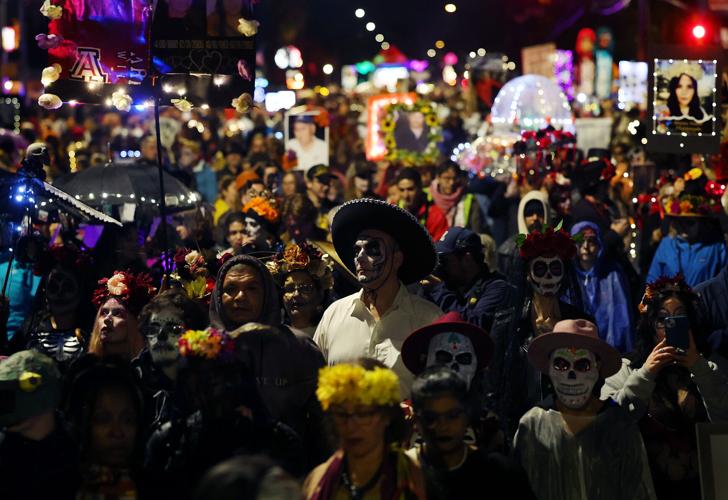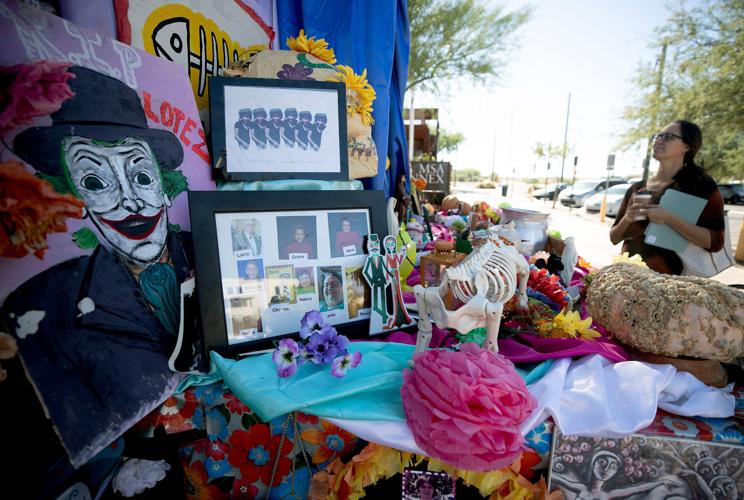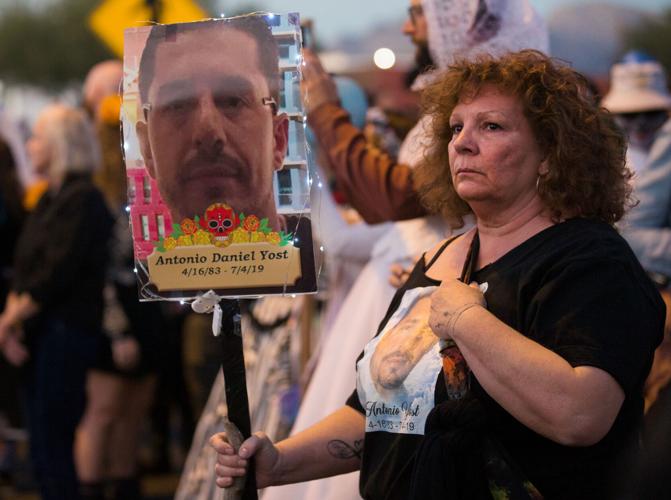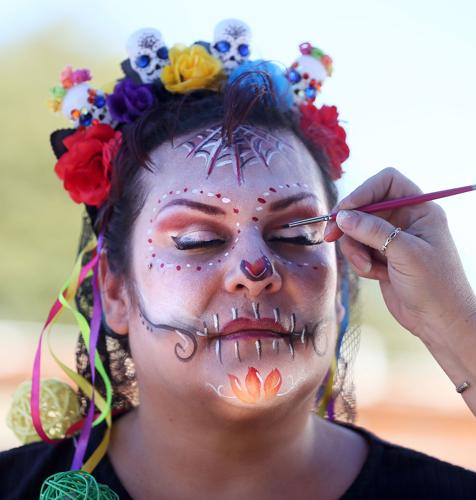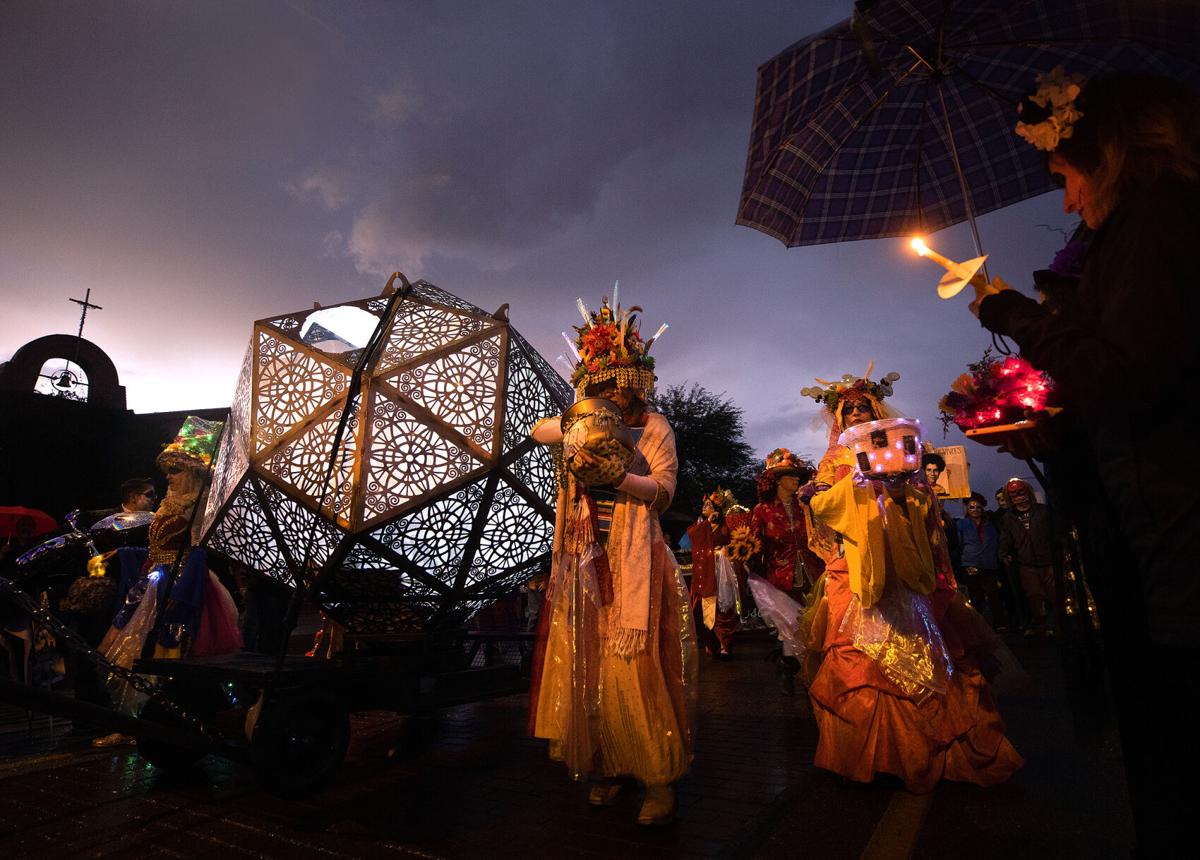It's a special time of year in Tucson to honor deceased loved ones.
The annual celebrations of D├Ła de los Muertos and the All Souls Procession make it so.╠²
Now in its 36th year, the All Souls Procession has its origins in the arts community of Tucson. The procession was created by performance artists, painters and sculptors as a way to honor the dead.╠²
ŌĆ£Back in the '90s, Susan Johnson, a well known local artist, and amazing sculptor, she started the All Souls Procession in memory of her father that passed away,ŌĆØ said Yvette Madison, social media director for All Souls Procession. ŌĆ£Over the years, it grew from 15 people to 20 people, to 25 to 50, and then just kept going.ŌĆØ

Jennifer Davila holds her homemade ofrenda filled with photos of loved ones who have died, before the start of the 34th Annual All Souls Procession in the Barrio Hollywood neighborhood on Nov. 5, 2023.
What originally started out as a small, artists' event has turned into a community celebration with an estimated 150,000 attendees yearly.
ŌĆ£The whole weekend there's an entire celebration,ŌĆØ Madison said.
Attendees can expect three days full of music, performances and community, with the procession and finale taking place the evening of Nov. 9, a Sunday.╠²
ŌĆ£Sunday is huge. You can expect to see people with floats and puppets and people walking around with their loved ones on poster boards and photos,ŌĆØ Madison said. ŌĆ£There's a lot to take in, a lot going on.ŌĆØ
There will also be community workshops leading up to the All Souls event, including memorial lantern-making with Odaiko Sonora from╠²5-8 p.m.╠²on Thursday, Oct. 30, at╠²Moto Sonora,╠², and an Obon Dance & Chant Workshop from╠²10:45am ŌĆō 12:15 p.m. Saturday,╠²Nov. 1, at╠²Rhythm Industry Performance Factory,╠².╠²
Madison, who has been a volunteer for All Souls for 16 years, described the procession as a powerful and moving experience.
ŌĆ£You can walk in this procession, or even just watch, and you can feel the love and celebration,ŌĆØ Madison said. ŌĆ£I think it's really beautiful to see how much work and dedication and everything that's gone into this procession for the last 36 years, and it still be a community-funded event. It's been very hard, but it's beautiful that it's been able to be here for so long.ŌĆØ
Over those 36 years, as the procession grew, some Tucsonans invented new traditions, and others brought their own cultural traditions with them.
D├Ła de los Muertos has become a strong influence in the procession.

Despite the rain hundreds of people march during the 35th Annual All Souls Procession in Tucson, Ariz. on November 3, 2024.
ŌĆ£It never was meant to take the place of D├Ła de los Muertos,ŌĆØ Madison said. ŌĆ£But we are a huge Hispanic city.ŌĆØ
The timing of the event, according to the procession's website, was inspired by the many cultures that see autumn as the time when the veil between the worlds is thinnest, and the dead are closest to us.
D├Ła de los Muertos, in particular, is observed in early November, usually falling on Nov. 1 and 2.
Though both celebrations honor the dead, D├Ła de los Muertos is its own holiday with its own rich traditions.
D├Ła de los Muertos is a time to pay respects and remember friends and family members who have died, and keep their memories alive. It is believed that during this time, deceased loved ones will visit the living.╠²

Monique Quihuis gets her face painted by Shannon Donavant before the start of the Annual All Souls Procession on Nov. 6, 2022.
The celebration has multiple cultural roots, said╠²Mathew Sandoval, a teaching professor at Barrett, the Honors College, at Arizona State University.
ŌĆ£Some of those roots obviously come from Spanish Catholicism, in so far as D├Ła de los Muertos is celebrated on November first and second, or around those traditional days, which are part of the Catholic liturgical calendar for All Saints Day,ŌĆØ Sandoval said.
ŌĆ£There's also indigenous cultural roots grounded in Mesoamerica and pre-Hispanic indigenous societies.ŌĆØ
Sandoval said there are also European pagan elements to D├Ła de los Muertos, as well as Arab influences, and West African elements resulting from the African slave trade in Latin America.
One of the ways the dead are honored during D├Ła de los Muertos is through the creation of ofrendas, or offerings, Sandoval noted.╠²╠²

Blair Feldman takes a look at the ofrenda at the MSA Annex in Tucson, Ariz. on October 31, 2023. The ofrenda, an alter set up to honor loved ones who have passed away, is displayed leading up to the All Souls Procession which takes place this Sunday.
ŌĆ£Traditionally, they're made within the home space, but oftentimes also theyŌĆÖre made in cemeteries or public plazas. These are altars that are erected in which you place offerings for the dead, things that they loved, things that they would want on their trip back from the land of the dead into the land of the living."
Lupita Zepeda, owner of Yolia Bot├Īnica,╠²,╠²a spiritual shop in Tucson specializing in Latin American products for spiritual practices, said ofrendas create visual and tangible representations of what lost loved ones meant to the living.
ŌĆ£Ofrendas are really personal, extremely personal,ŌĆØ she said. ŌĆ£If it means something to you, if it triggers the skip of a beat in your heartbeat, and it raises the chills on your back, then that's what needs to go on your ofrenda.ŌĆØ
There are also folk healing and indigenous-rooted approaches to ofrendas, Zepeda said, that revolve around honoring the elements.
ŌĆ£That's where we start tapping into the energies of water, air, earth and fire. We do also have the belief that there's a fifth element, which is the soul that connects all the other ones,ŌĆØ she said.
Each of those elements can be represented in some form on an ofrenda.╠²
ŌĆ£Rocks, crystals, branches, leaves, dry flowers, anything that is being nurtured, or has been nurtured by the energy of the earth, is a good representation of Earth in your altar,ŌĆØ Zepeda said.
ŌĆ£Candles, incense, anything transformative, Phoenix, butterflies, those are all great representations of fire energy.
"And water ŌĆö seashells, things that evoke a lot of emotion or are thought-provoking. In Mexican tradition, we do a lot of tequila, a lot of mezcal, and besides that being part of the offering, it doubles as a representation of the water element, because it's a liquid.
"And then we have air. Air can be also incense and candles, but it can also be anything that is connected to communication. The Element of Air rules our thoughts and our ideas and the way we communicate. So sometimes just writing letters, writing notes, writing things to our loved ones and leaving them on our altar, notes, poems, love letters, anything like that is a wonderful addition.ŌĆØ
To prepare for D├Ła de los Muertos, Zepeda said she will be offering a walk-in workshop Thursday Oct. 30 and Friday Oct. 31, where customers can create their own herbal mix with resin from the sacred Copal tree to use in offerings.
ŌĆ£I'll just have a couple of tables set up with all the materials. We'll have printouts for people to read. It'll be very self led, very chill. It's not a complicated process. Everything's going to be laid out for them, and they'll just be able to come in during normal store hours from 10 a.m. - 7 p.m., and build their own little resin jar,ŌĆØ Zepeda said.╠²
If youŌĆÖre looking for other ways to connect with those who have passed, and honor your loved ones, youŌĆÖll find plenty of community events to celebrate both All Souls and D├Ła de los Muertos.

The 33rd Annual All Souls Procession on Nov. 6, 2022.
All Souls Community Altar Dedication Ceremony
Altar Dedication Ceremony with Ruben Urrea Moreno, Danza Azteca Coatilque and Homicide Survivors Inc.
When: 6-8 p.m. Tuesday, Nov. 4
Where: MSA Annex,╠²╠²
Cost:╠²Free
Dance of the Dead ŌĆö Flow for the Soul
Kick off your All Souls celebrations with this family-friendly community event featuring LED flow, dancing, fire performance, and DJ tunes by ŌĆ£Tech house troublemakers,ŌĆØ Max Low, and MNTRA.
When: 6-11:55 p.m. Friday, Nov. 7
Where: MSA Annex,╠²╠²
Cost: $30
Visit the for more information.
Procession of Little Angels
Bring the whole family for a free day of art activities, music, performance and a pint-sized sunset procession for small children and families. The day will be filled with special programming by Stories That Soar, Tucson Girls Chorus and Las Aguilitas de Davis Elementary, including face paint artisans, DIY stations and family altars.
When: 3-7 p.m. Saturday, Nov. 8
Where:╠²Literacy Connects Campus,╠²
Cost:╠²Free
Dance of the Dead
Enjoy a grounding evening of music and ceremony. Sound Journey with Kati Astraeir and John Vorus, Cacao Ceremony with Readings of Luz, and curated vendors by Visionayr House Market and Solar Culture Gallery.
When: 5-11:55 p.m. Saturday, Nov. 8
Where: MSA Annex,╠²╠²
Cost: $30
Visit the for more information.
All Souls Procession and Finale Ceremony
The All Souls procession will end at the MSA Annex with a grand finale featuring Nexus Visions, Snow Raven, Odaiko Sonora, Flam Chen, Circus Sanctuary and Community Spirit Groups╠²
When: 4 p.m., assemble; 6 p.m., procession starts, Sunday, Nov. 9
Where: Procession begins at Speedway and Grande Avenue, and the finale ceremony takes place at the MSA Annex,╠²╠²
Cost:╠²Free
D├Ła de los Muertos: A Celebration of Life - Tucson Symphony Orchestra
Celebrate the rich musical traditions of D├Ła de los Muertos in this collaboration between the Tucson Symphony Orchestra and the Tucson International Mariachi Conference.╠²
When: 7:30 p.m. Saturday, Nov. 1
Where: Linda Ronstadt Music Hall,╠²
Cost: Tickets from $24.80 ŌĆō $81.10.
Visit the for more information.
D├Ła de los Muertos Celebraci├│n - Tucson Botanical Gardens
Spend the afternoon celebrating D├Ła de los Muertos in Tucson Botanical GardensŌĆÖ ŌĆ£Nuestro Jard├Łn,ŌĆØ with beautiful floral displays, an ofrenda to honor the lives of family and friends who have passed, mariachi and puppet performances, and festive educational programming for the whole family.
When: 2 p.m. Sunday, Nov. 2
Where: Tucson Botanical Gardens,╠²
Cost:╠²Adults (18-61) $19; children (4-12) $10; students (13-17), $15; seniors (62+) $15
Visit the for more information.
D├Ła de los Muertos Ofrendas - Tucson Presidio Museum
The Presidio Museum will host ofrendas created by the community. Presidio staff, board members and volunteers will also create public ofrendas to honor veterans, friends and family of the Tucson Presidio Trust, and pets. Community ofrendas will include: Hearts That Purr, Sky Island Alliance, City High, Los Descendientes, Thrift Store Ancestors, Old Souls, and Cholla Afterlife.
When: 10 a.m. - 4 p.m. daily through Nov. 9
Where: Presidio San Agust├Łn del Tucs├│n Museum,╠²
Cost: Adults (13+) $9; children (6-13) $6; seniors (65+); military, Pima County residents: $3 off per person.
Visit the for more information.╠²
D├Ła de los Muertos Celebration at Park Place
Enjoy live art demonstrations by local painters, mariachi music, calavera face painting, and Folkl├│rico dancers who bring the spirit of D├Ła de los Muertos to life. YouŌĆÖll also find an ofrenda filled with colorful florals, intricate decorations, and sculptures.
When: 11 a.m. ŌĆō 2 p.m. Saturday, Nov. 8╠²╠²
Where: Park Place Mall,╠²
Cost: Free to attend
Visit the for more information.
Chiles, Chocolate & Day of the Dead Festival - Tohono Chul
Treat yourself to a delectable fusion of flavors and traditions with dozens of food vendors, local craftspeople, and entertainers. Immerse yourself in the artistry of personal ofrendas crafted by local artists and students, paying homage to the enduring borderland traditions of D├Ła de los Muertos. You can even leave personal recuerdos (remembrances) for lost loved ones at the community altar. Kids can enjoy free craft activities and complimentary face painting for D├Ła de los Muertos.
When: 9 a.m. ŌĆō 4 p.m. Friday, Oct. 31 and╠² Saturday, Nov. 1
Where: Tohono Chul,╠²
Cost: General admission, $25; Tohono Chul members, $10; children (4-12), $7; children under 4 get in free
Visit the for more information.
"Ofrendas: Life Beyond Death,ŌĆØ by Arizona Folkl├│rico Dance Studio╠²
Experience the vibrant traditions and cultural origins of D├Ła de los Muertos in a stylized folk dance production, brought to you by the dancers of Arizona Folkl├│rico Dance Studio.
When: Green Valley, 7 p.m. Friday, Oct. 24; Tucson, 7 p.m. Saturday, Nov. 1
Where: Green Valley Recreation West Center Auditorium,╠², and Pima Community College Center for the Arts,╠²
Cost: $22 per seat╠²
Visit the for more information.

